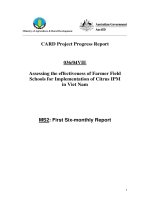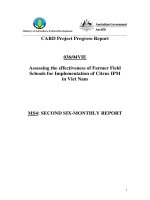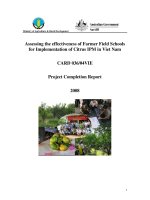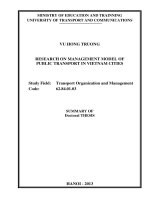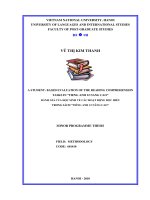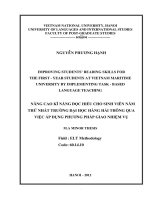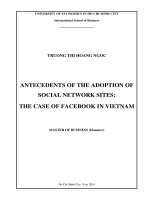A needs based evaluation of materials used in an ESP course for nautical students at a maritime university in viet nam
Bạn đang xem bản rút gọn của tài liệu. Xem và tải ngay bản đầy đủ của tài liệu tại đây (2.55 MB, 91 trang )
VIETNAM NATIONAL UNIVERSITY, HANOI
UNIVERSITY OF LANGUAGES AND INTERNATIONAL STUDIES
FACULTY OF ENGLISH LANGUAGE TEACHER EDUCATION
GRADUATION PAPER
A NEEDS-BASED EVALUATION OF MATERIALS
USED IN AN ESP COURSE FOR NAUTICAL
STUDENTS AT A MARITIME UNIVERSITY IN
VIETNAM
Supervisor: Lê Thị Hồng Duyên, Ph.D
Student: Hoàng Minh Anh
Course: QH2017.F.1.E1
HÀ NỘI – 2021
ĐẠI HỌC QUỐC GIA HÀ NỘI
TRƯỜNG ĐẠI HỌC NGOẠI NGỮ
KHOA SƯ PHẠM TIẾNG ANH
KHÓA LUẬN TỐT NGHIỆP
ĐÁNH GIÁ TÀI LIỆU TIẾNG ANH CHUYÊN NGÀNH
HÀNG HẢI TẠI MỘT TRƯỜNG ĐẠI HỌC HÀNG
HẢI Ở VIỆT NAM DỰA TRÊN NHU CẦU CỦA SINH
VIÊN
Giáo viên hướng dẫn: TS. Lê Thị Hồng Duyên
Sinh viên: Hoàng Minh Anh
Khóa: QH2017.F.1.E1
HÀ NỘI – 2021
ACKNOWLEDGEMENTS
This study could not have been completed without the guidance and support of
several individuals whose contributions are gratefully appreciated by the
researcher.
First and foremost, I would like to express my sincerest appreciation to Mrs.
Le Thi Hong Duyen, my researcher supervisor, who always supported and guided
me unconditionally. Thanks to her comprehensive insight into the field of ESP in
general and research skills in particular as well as continuous supervision, I was
able to conduct my research and finalize my thesis paper.
Moreover, profound knowledge and constructive advice from my ESP
teacher, Mrs. Nguyen Thuy Phuong Lan are of such great help that without her
valuable support, I could not have had such a deep understanding of ESP.
Furthermore, I also want to acknowledge the help willingly provided by all
the participants, who come from a nautical university in Vietnam. Without their
cooperation in completing the survey and interviews, the success of my research
would not have been accomplished.
My special thanks are extended to all members from QH2017.E1 and my
precious family members. They never failed to provide me with technical and
mental support so as to overcome all the difficulties that arose.
Last but not least, I would love to express our thankfulness to my fellow,
Ta Minh Loan, who made relentless efforts to motivate and accompany me on the
completion of my thesis paper.
i
I hereby state that I: Hoàng Minh Anh, 17E1 being a candidate for the degree
of Bachelor of Arts in English Language Teaching accept the requirements
of the College relating to the retention and use of Bachelor’s Graduation
Paper deposited in the library.
In terms of these conditions, I agree that the origin of my paper deposited in
the library should be accessible for the purposes of study and research, in
accordance with the normal conditions established by the librarian for the
care, loan or reproduction of the paper.
Hà Nội, 04/05/2021
Signature
Hoàng Minh Anh
ii
ABSTRACT
Materials evaluation, including textbook evaluation, plays an important role in any
English language teaching courses as well as English for Specific purposes
courses, as it helps to identify the effectiveness of the materials in meeting the
needs of learners. This study aims to evaluate an ESP textbook used for students
at a nautical university in Vietnam based on the analysis of the needs of 40 students
studying the major Global studies and Maritime Affairs, on the grounds that the
in-use material is directly imported from a university in America, whose culture
might contrast sharply with ours. A mixed-methods approach was adopted: 40
questionnaires were administered to students who have just completed the course
“Foreign language 1”; semi-structured interviews were conducted with 3 students,
and a teacher; and document analysis was employed as a subsidiary research
method. Thanks to the triangulation of data collection tools, significant findings
have been drawn from the responses. Firstly, the textbook is a satisfactory option
for students in terms of audience, aims and content. Secondly, there is still a
mismatch between students’ real needs and the available resources in certain
aspects. The aspects that require further modifications and adaptations in the future
include the display of content in the textbook, the procedure of an ESP lesson and
the orientation towards communicative approach in teaching and learning this
subject. The results are of paramount importance for designers and lecturers at this
university as they reflect the real needs of students and the effectiveness of the
textbook in fulfilling those needs. Further research should be done on other
stakeholders like teachers, textbook designers or employers to better improve the
quality of learning and teaching ESP there.
iii
TABLE OF CONTENTS
Acknowledgements
Abstract
List of figures, tables, and abbreviations
CHAPTER ONE: INTRODUCTION ............................................................................ 1
1.1. Rationale for the study ................................................................................................... 1
1.2. Research aims and research questions ...................................................................... 3
1.3. Scope of the study .......................................................................................................... 4
1.4. Contributions of the research ...................................................................................... 4
1.5. Research methods of the study ............................................................................. 4
CHAPTER TWO: LITERATURE REVIEW ............................................................ 6
2.1. English for Specific Purposes (ESP) .......................................................................... 6
2.1.1. Definition of ESP ................................................................................................. 6
2.1.2. Classification of ESP ................................................................................... 8
2.1.3. English for Global studies and Maritime Affairs .................................. 10
2.2. Needs analysis ....................................................................................................... 11
2.2.1. Definition of Needs ................................................................................... 11
2.2.2. Types of Needs .......................................................................................... 11
2.2.3. Needs analysis ........................................................................................... 12
2.3. Material Evaluation .............................................................................................. 13
2.3.1. Definition of materials ............................................................................. 13
2.3.2. Material Evaluation .................................................................................. 14
2.3.2.1. Definition of material evaluation ............................................... 14
2.3.2.2. The aims of material evaluation ................................................ 14
2.3.2.3. Types of material evaluation ...................................................... 15
2.3.2.4. Models of material evaluation .................................................... 16
2.3.2.5. Techniques for material evaluation ........................................... 17
2.4. Review of previous studies ................................................................................. 17
CHAPTER THREE: METHODOLOGY ................................................. 19
3.1. Research setting ............................................................................................ 19
3.2. Research participants and sampling ................................................................... 21
3.3. Data collection procedure and methods ............................................................. 22
iv
3.4. Data analysis procedure and methods .......................................................... 24
CHAPTER FOUR: RESULTS AND DISCUSSION ................................. 26
4.1. Research question 1: What are the students’ English language needs as
perceived by students at a maritime university in Vietnam? .................................. 26
4.2. Research question 2: To what extent are these needs addressed in the current
ESP material? ................................................................................................................ 35
4.3. Major findings and discussion ........................................................................... 47
4.4. Recommendations for adaptation ....................................................................... 48
CHAPTER FIVE: CONCLUSION .................................................................. 53
REFERENCES
APPENDIX 1 Checklist of criteria for objective and subjective analyses
(Hutchinson and Waters, 1987)
APPENDIX 2 Questionnaire for the students (English version)
APPENDIX 3 Questionnaire for the students (Vietnamese version)
APPENDIX 4 Guided interview questions for teachers
APPENDIX 5 Guided interview questions for students
APPENDIX 6 Interview Transcripts
APPENDIX 7 An extract of unit 8 from the textbook “Foreign language 1 –
Global studies and Maritime affairs”
v
LIST OF FIGURES, TABLES, AND ABBREVIATIONS
List of figures
Figure 1 ESP classification by experience ..................................................................................... 8
Figure 2 ESP classification by professional area ....................................................................... 9
Figure 3 The material evaluation process .................................................................................... 16
Figure 4 Students’ levels of English ............................................................................................... 26
Figure 5 Students’ understanding levels of their specialized subjects ...................... 27
Figure 6 Students’ views on the importance of the course “Foreign language 1”
.................................................................................................................................................................................... 28
Figure 7 Students’ views on the proportion of language skills in the textbook
“Foreign language 1” .................................................................................................. 41
Figure 8 Students’ views on the number of technical vocabularies in each topic
in the textbook “Foreign Language 1” ....................................................................... 42
Figure 9 Students’ views on the number of grammatical points in the textbook
“Foreign Language 1” .................................................................................................. 43
Figure 10 Students’ views on the level of difficulty of the textbook’s content... 45
List of tables
Table 1 Students’ expectations of the course “Foreign language 1 in Global
Studies and Maritime Affairs” ............................................................................................................... 29
Table 2 Students’ views on the aims of the textbook “Foreign Language 1” ........ 30
Table 3 Students’ views on the topics of the textbook “Foreign Language 1” ..... 32
Table 4 Students’ views on the skills of the textbook “Foreign Language 1” ....... 33
Table 5 Students’ views on the methodology of the textbook “Foreign Language
1”............................................................................................................................................................................... 34
Table 6 Students’ level of satisfaction of the aims in the textbook “Foreign
Language 1” ..................................................................................................................................................... 36
Table 7 The students’ level of satisfaction with the how the topics were
developed in the textbook “Foreign Language 1”..................................................................... 38
Table 8 Students’ level of satisfaction with the use of methodology in the
textbook “Foreign language 1”.............................................................................................................. 46
vi
List of abbreviations
ESP
English for Specific Purposes
ELT
English Language Teaching
EAP
English for Academic Purposes
EOP
English for Occupational Purposes
EPP
English for Professional Purposes
EVP
English for Vocational Purposes
EST
English for Science and Technology
EMP
English for Medical Purposes
ELP
English for Legal Purpose
CEFR
Common European Framework of Reference for Languages
DVD
Digital Video Disc
ISE
International School of Education
GMA
Global studies and Maritime affairs
IELTS
International English Language Testing System
vii
CHAPTER ONE: INTRODUCTION
This chapter will provide a brief introduction of this research paper, including the
rationale for the study, the scope and research methods of the study as well as
expected contributions. More importantly, an insight into research aims and
research questions is also offered in this chapter.
1.1. Rationale for the study
Globalization paves the way for global integration in numerous aspects: economy,
social, politics, and culture. In this context, Vietnam has gradually shifted from a
centrally planned to an open, competitive market by means of builing up bilateral
relations in trade and entering into multilateral trade agreements in those areas.
Vietnam’s internationally economic climate has been accelerated explosively
under a protocol to comply with international rules and standards of global
economy and security.
One of the fundamental fields that Vietnam’s government puts an emphasis on is
Maritime. Vietnam is endowed with a territory that stretches over three thousand
kilometers on the western edge of the South China Sea as well as a territorial sea
area of over one million square kilometers. It goes without saying that the Vietnam
Sea is of paramount importance to the ecology and biodiversity of the East Sea and
surrounding regions. It also serves as “an exclusive transitional zone between the
Indian Ocean and the Pacific Ocean in terms of biological and maritime
geography” (Duong and Dong, 2019). It is inevitable that a modernized and
industrialized economy must be developed in connection with boosting the
potential of the ocean, especially when Vietnam has enormous benefits in sea
space resources. However, such competitive advantages also require Vietnam to
devote assiduous attention to the policy of defence and security lest any issues
related to regional peace and national interest arise.
Vietnam’s participation in the 1982 UN Convention on the Law of the Sea
(UNCLOS) has led to the creation and development of fine-tuned laws on maritime
1
issues. These laws create a legal framework for fishery exploitation, management
and protection to boost local socio-economic development and strengthen
Vietnam’s relations with other countries. Stated in Vietnam Maritime Strategy
2020, besides becoming a coastal country with robust economic growth, Vietnam
holds the opinion that developing economy must be accompanied by firmly
defending national sovereignty. To execute this policy, the supply of the seafarers
having qualified professional competencies and communicative competence,
especially English command, is a must.
In reality, the ability to communicate well proves critical in dealing with problems
related to national sovereignty, sovereign rights and jurisdiction at sea. Hence,
there is a call for the same common language that the seafarers can use at sea. In
this case, English, the dominant language in certain scientific fields (Graddol,
1997), appears to be the most feasible one. However, General English might not
be effective in a specific situation like this due to its inability to compensate for
communication breakdowns occurring in job-related contexts at a satisfactory
level (Wu & Chin, 2010). Therefore, it is essential that tailor-made English training
courses for each specific job are provided to meet students’ need. This reflects an
increasing demand for English for Specific Purposes (ESP), which is specially
designed in direct relation to the learners’ working situations. In an attempt to fulfil
the needs of workers in maritime-related positions, Maritime English came into
existence.
Unlike General English, Maritime English is known as key phrases utilized in the
maritime industry with a view to preventing incidents and language obstacles
arising by a difference in language fluency (Pritcard, 2009). To make
communication within maritime context less ambiguous, relevant and specific
terms bring dividends. These lexical resources prove its importance in a variety of
reasons like enhancing the safety of the crew, the effectiveness of daily working
and the integrity of the ship. In a smaller scale, English for Global Studies and
Maritime Affairs refers to English vocabularies and phrases specifically used in
2
global matters and maritime trade. It therefore plays a pivotal role in resolving
contemporary maritime security challenges and assisting in the trade partnership
with other counterparts all over the world.
Despite its vital role, little attention has been paid to design an appropriate
curriculum and pedagogical settings to improve the command of Maritime English
for both students and in-service seafarers. At one of the biggest maritime
universities in Vietnam, all the materials for the course “Global studies and
Maritime affairs” are directly imported and adapted from the materials in a
Maritime Academy in America, whose culture might contrast sharply with that of
Vietnam. Besides, there is no previous study examining the suitability of adopting
foreign materials for “English for Global Studies and Maritime” into Vietnamese
context in general and students’ actual needs in particular. Thus, it is important
that the in-use materials should be meticulously investigated to prove whether they
accommodate the special needs of the learners and whether they reflect the
pedagogical settings and current context in Vietnam.
1.2. Research aims and research questions
The main objective of this study is to evaluate an ESP material used for students
at a nautical university in Vietnam based on the analysis of learners’ needs. It is
then followed by several suggestions of adaptation if needed for the course
designers. This aim is formulated through the overarching research question: Does
the current ESP material at a maritime university in Vietnam adequately address
the needs of the students for their academic studies and for their target careers?
This overarching research question is fractured into two following subsidiary
questions:
(i) What are the students’ English language needs as perceived by students
at a maritime university in Vietnam?
(ii) To what extent are these needs addressed in the current ESP material?
3
These above-mentioned research questions will be discussed in-depth after the data
have been collected and analyzed meticulously in the chapter 3.
1.3. Scope of the study
The target population in this research are the second-year credit students who have
been studying Global Studies and Maritime Affairs at a maritime university in
Vietnam.
1.4. Contributions of the research
The evaluation can measure the effect of the materials or determine the
effectiveness of the existing materials whilst using them. It provides the teachers
or the course designers with information that allows them to determine the
effectiveness of the materials and decide whether further modifications of the
current materials are needed for future use (Mukundan, 2009, p.37). Moreover, the
credit students are the target users of the ESP course books and other relevant
learning materials; thus it is of great importance that the students’ needs are
addressed in the ESP books. If not, some recommendations of modification or
adaptation are provided to better serve the needs of the students.
1.5. Research methods of the study
This study employs a mixed methodology in an attempt to answer these abovementioned questions. The three instruments utilized in the study are
questionnaires, semi-structured interviews and document analysis. In the survey
study, questionnaires are used to obtain data of the learners about their necessities,
wants and lacks and information about their background such as their English
competence level, their purposes in learning English and their expectations
towards this ESP course. In the survey design, informants are also enquired about
their opinions regarding the aims, content and methodology of the in-use textbook.
To be more specific, data on students’ evaluations of the importance and level of
satisfaction with maritime-related topics, the difficulty level of lexical items and
grammatical points, and language skills covered by the textbook are collected
4
thanks to the questionnaire. In terms of semi-structured interviews, several
lecturers and students at the faculty are enquired about their special needs in
learning Maritime English as well as their evaluation of the appropriateness of the
in-use materials. For document analysis, to enhance the objectivity of material
evaluation, compared to previous studies, this study utilizes documents which are
interpreted by the researcher to give voice and meaning around an assessment topic
(Bowen, 2009).
5
CHAPTER TWO: LITERATURE REVIEW
In this chapter, an overview and evaluation of the available literature in the field
of ESP and material evaluation will be offered, followed by a review of previous
related studies. This literature review will provide an in-depth insight into the key
terms of ESP materials evaluation and the framework of needs analysis and
material evaluation to show where this study fits into and identify gaps in existing
body of knowledge.
2.1. English for Specific Purposes (ESP)
2.1.1. Definition of ESP
In Hutchinson and Waters’ “The Tree of ELT” (1987), it can be observed that ESP,
together with General English, is one branch of English as a Foreign Language
(EFL). Such division requires close scrutiny and investigation into the nature and
characteristics of ESP to unveil some significant differences. There are a great
diversity of definitions concerning the concept; however, despite this variation, a
striking similarity is highlighted after reviewing some of the key definitions.
Hutchinson and Waters (1987) see ESP more of an approach than a product. The
authors argue that neither a special kind of language nor methodology can define
the term ESP. Instead, ESP should be seen as “an approach to language learning,
which is based on learner need” (p.19). In other words, according to Hutchinson
and Waters (1987), the needs and interests of learners lay the foundation for ESP.
McDonough (1984) also shares the primacy of need analysis in designing an ESP
course by stating that “the idea of analysing the language needs of the learner as a
basis for course development has become almost synonymous with ESP in recent
years and it is difficult to think of one without the other coming to mind” (p.29).
This notion is agreed by Robinson (1991), who concedes that ESP is "normally
goal-directed" and its course proceeds from a needs analysis.
Strevens (1988) provides an extended definition of ESP by identifying four
absolute characteristics and two variable characteristics. The four absolute
6
characteristics of ESP describe English language teaching that is, according to
Strevens (1988):
(i) designed to meet specified needs of the learner;
(ii) related in content (i.e. in its themes and topics) to particular disciplines,
occupations and activities;
(iii) centred on the language appropriate to those activities in syntax, lexis,
discourse, semantics, etc., and analysis of this discourse;
(iv) in contrast with General English.
Meanwhile, the two variable characteristics are presented as followed:
ESP may be, but is not necessarily:
(i) restricted as to the language skills to be learned (e.g. reading only);
(ii) not taught according to any pre-ordained methodology (pp.1-2).
Dudley-Evans and St John (1998) share some areas of agreement with Streven;
however, they do not think that ESP courses should be necessarily related directly
to subject content as Strevens (1988) and Robinson (1991) propose. In their
modified definition, Dudley-Evans and St. John (1998) remove the last absolute
characteristic that “ESP is in contrast with General English” and add three more
variable characteristics. Moreover, specific ESP teaching is asserted to possess its
own methodology. The ESP methodology in Dudley-Evans and St. John’s theory
refers to the roles of students and the teacher in an ESP class, in which “teacher
sometimes becomes more like a language consultant, enjoying equal status with
the learners who have their own expertise in the subject matter” (p.4).
It is a mutually agreeable conclusion that the learners’ needs are critical to an ESP
course, which then determine syllabus design and appropriate methodology. In the
context of this study, ESP can be understood as the teaching and learning of
specific English to learners who will utilize it both in their current academic study
as nautical students and in their future careers in the field of maritime, so that they
are able to communicate efficiently in specific contexts.
7
2.1.2. Classification of ESP
ESP can be divided into two sub-categories: English for Academic Purposes (EAP)
and English for Occupational Purposes (EOP) (McDonough, 1984; Hutchinson
and Waters, 1987; Robinson, 1991; Jordan, 1997; Dudley-Evans and St John,
1998; Belcher, 2006; Krzanowski, 2008). Under the umbrella of EAP and EOP,
there are different subtypes according to the way they are categorized, either by
experience or by professional area.
In terms of experience’s classification, the tree diagram is presented in Figure 1
(Robinson, 1991, pp.3-4, as cited in Dudley-Evans & St John, 1998).
Figure 1. ESP classification by experience
Dudley-Evans and St John (1998) place a high value on this division of ESP, as
there might be great distinctions between pre-experience or pre-study courses and
those that are designed for in-service learners.
Another way of classification is by discipline or professional area. The tree
diagram demonstrating it is illustrated in Figure 2 (Dudley-Evans & St John,
1998).
8
English for Specific Purposes
English for Academic Purposes
English for Occupational Purposes
English for
English for
English
English for
English for
Science and
Medical
for Legal
Management
Professional Vocational
Technology
Purposes
Purposes Finance and
English for
Purposes
Purposes
Economics
English for
English for
Medical
Business
Purposes
Purposes
Pre-Voca- Vocational
tional
English English
Figure 2. ESP classification by professional area
EOP is related to English “that is not for academic purposes; it includes
professional purposes in administration, medicine, law and business, and
vocational purposes for non-professionals in work or pre-work situations”
(Dudley-Evans and St John, 1998, p.7). The aim of an EOP course is to develop
language skills required in learners’ jobs, for professional purposes. EOP can be
subdivided into English for Professional Purposes (EPP) and English for
Vocational Purposes (EVP) or Vocational English (Dudley-Evans and St John,
1998: 6). Unlike EOP, EAP is educational by nature, as it is regarded as “the
teaching of English with the specific aim of helping learners to study, conduct
research or teach in that language” (Flowerdew and Peacock, 2001, p.8). In EAP,
there are English for Science and Technology (EST), English for Medical Purposes
(EMP), English for Legal Purpose (ELP) and English for Management Finance
and Economics. An EAP course makes an attempt to provide learners the language
and skills to serve academic purposes.
English for Global studies and Maritime Affairs that this study is examining fits
into the category of EAP.
9
2.1.3. English for Global studies and Maritime Affairs
Global studies and Maritime Affairs is developed to equip students of this major
with the necessary knowledge and skills for their academic studies and future
career. To study this major, learners have to acquire knowledge about four
maritime policy areas, namely International Maritime Security, International
Maritime Environmental Policy, Maritime Law and Organizations, and
International Maritime Trade and Policy. The aim in each of these core areas is to
present students with a theoretical foundation drawn from the social science fields
of international relations, political science, public policy, history, and economics.
In addition, students gain the intellectual tools necessary to understand maritime
policy issues in an increasingly globalized world. These include critical thinking,
quantitative and non-quantitative research capability, leadership skills, and cultural
and diversity awareness.
In the global context, it is therefore necessary that the students possess a good
command of both General English and English for specific purposes. According
to information available publically on the website of the university on which the
study is conducted, certain learning objectives for a course English for Global
studies and Maritime Affairs are briefly summarized as follows:
Develop a lexical repertoire (CEFR level B1-B2) related to the field
of Global studies and Maritime Affairs
Employ job-related language functions to communicate effectively
in different situations
Articulate and analyze, both verbally and in writing, the current
issues facing the maritime policy and management fields, and can
develop appropriate solutions
Be aware of the importance of cultural diversity and cross-cultural
understanding, and develop a sense of civic responsibility and global
stewardship
10
2.2. Needs Analysis
2.2.1. Definition of Needs
The term “needs” in the context of second language learning is defined in a variety
of ways by different scholars. Widdowson’s definition (1981) equals needs to the
requirement of learners in the present or future as well as their expectations after
the language course ends. Like Widdowson, Mountford (1981) also provides a
goal-oriented definition considering needs as purposes of the learners’ study or
working requirement. According to Dudley-Evans and St. John (1998), goaloriented needs originate from learning situations.
On the contrary, Richterich (1980) states that background information of the
learners and their expectations should serve as the basis for the diagnosis of
language needs. In the definition of Brindley (1989), needs are similar to learners’
“wants” or “desires”, concerning learners’ own interests in what they would like
to learn besides their program requirements. Berwick (1989) regards “needs” as
“the gap between the current situation and the anticipated future state” (p.52). The
needs that are mentioned in Richterich, Brindley and Berwich’s definitions are
process-oriented ones, which draw from a target situation rather than learning
situations (Dudley-Evans & St. John, 1998).
2.2.2. Types of Needs
Not only Brindley (1989) but also Robinson (1991) provide the broad
classification of needs into two different characteristics, namely objective needs
and subjective needs. “Objective needs” draws from the “factual information” of
learners, including their language proficiency, the perceived language difficulties
and their demand for language in real communication situations. In contrast,
“subjective needs” takes the language learning cognition and emotional needs of
learners into consideration. This type of “needs” is interpreted by examining the
“affective and cognitive factors” of the learners such as learners’ personalities,
self-confidence, personal cognitive styles, and expectations, and self-esteem
during the learning process.
11
Hutchinson and Waters (1987) introduce two concepts of needs: “target needs”
and “learning needs”. “Target needs” can be considered as what the students need
to behave in the target situation and refers to the learner’s “necessities”, “lacks”
and “wants” for functioning effectively in the target situation. To be specific,
“necessities”, also known as “objective needs”, is the needs defined by the
demands of the target situation. The language that the students are supposed to
perform well in the target situation is what is called “necessities”. “Lacks” refers
to the gap between the target competency level and the existing competency level
of the learners. “Wants” is what learners consider as their subjective needs. The
other concept, “learning needs”, denotes what students need to behave in order to
learn, and it deals with the learner’s background information such as motivation
and attitudes, interests, personal reasons for learning, learning styles and the
physical context namely resources and time available. The definition of
Hutchinson and Waters (1987) is adopted in this study with the aim of evaluating
the needs of the learners.
2.2.3. Needs Analysis
The term “needs analysis” was coined in 1920 by Michael West in an attempt to
propose a method of learning English effectively. Richard and Rodgers (1986)
assert that a language needs study involves the identification of English language
needs through improving aims, purposes and the subject matter in language
courses. Either general factors or a particular demand can be the main focus of the
study.
Needs analysis is defined by Basturkmen (1998) as "the identification of
difficulties and standard situations by observation of participants functioning in a
target situation in conjunction with interviews and questionnaires” (p.2).
According to her, "Language needs analyses are most often used where the learners
in selected situations face very similar difficulties” (p.2).
12
Richterch and Chancerell (1987) as cited in Basturkmen (1998) state that "the aim
of needs analysis is not only to identify elements but to establish relative
importance, to find out what is indispensable, necessary or merely desirable” (p.2).
According to Brown (1995), needs analysis is the process of gathering data which
assists in developing a curriculum that caters to the specific needs of a group of
learners. It plays an integral and indispensable role in systematic curriculum
design.
2.3. Material Evaluation
2.3.1. Definition of materials
Materials can be defined as whatever that assists in the process of teaching
language. They can be in the form of a textbook, a workbook, a cassette, a CDROM, a video, a photocopied handout, a newspaper, a paragraph written on a
whiteboard or anything which presents or informs about the language being
learned (Tomlinson, 1998).
According to Tomlinson (2001), materials refer to anything that is utilized to
facilitate the learning of a language. These materials can be linguistic, visual,
auditory or kinesthetic. They can be displayed in print, live performance, on
cassettes, CD-ROM, DVD, or on the internet.
Hutchinson and Torres (1994) state that:
The textbook is an almost universal element of [English language] teaching.
Millions of copies are sold every year, and numerous aid projects have been
set up to produce them in [various] countries…No teaching-learning
situation, it seems, is complete until it has its relevant textbook. (p.315)
Concerning the purposes of materials, Hutchinson and Waters (1987) define six
objectives for materials. The objectives are presented as follows:
The materials should
(i) provide a stimulus for learning;
(ii) help to organize teaching and learning process;
13
(iii) embody a view of the nature of language and learning;
(iv) reflect the nature of the learning task;
(v) have a very useful function in broadening the basis of teacher training;
and
(vi) provide models of correct and appropriate language use.
As a source of “real language” (Dudley-Evans and St John, 1998, p.171), materials
play a key role in give learners the exposure to how the language is actually uttered
in authentic contexts. Therefore, materials are of special importance to ESP,
especially when ESP is designed to support learners well in a work environment.
2.3.2. Material Evaluation
2.3.2.1. Definition of material evaluation
There are some definitions of material evaluation put forward by different authors
of ELT. Tomlinson (1998, p.3) defines material evaluation as “a systematic
appraisal of the value of materials in relation to their objectives and to the
objectives of learners using them.” This means that Tomlinson believes the
evaluation of a material should be based on the learners’ needs.
Hutchinson and Waters (1993) also think of the process of evaluation as a matching
process between the needs and available solutions. The process should involve
determining what needs to be evaluated, what the objectives and requirements of
the material are and deciding how the material being evaluated is suitable for the
objective and requirements determined before.
2.3.2.2. The aims of material evaluation
Material evaluation plays a crucial role in designing an ESP course. Several
reasons for textbook evaluation are listed by Sheldon (1988), one of which is that
textbook evaluation helps teachers familiarize themselves with the content of
available textbooks and identify the strengths and weaknesses of each.
14
Cunningsworth (1995) and Ellis (1997) hold the opinion that evaluation is a means
of performing action research whose aim is to achieve professional development
and improvement.
The aims of evaluating materials are: (a) To identify how successful the materials
used in the classroom are; (b) To examine whether the materials fulfil the
prescribed course objectives; (c) To examine the extent to which materials permit
students to achieve the learning objectives; and (d) To identify whether the designs
of the materials are suitable for a task-based syllabus.
2.3.2.3. Types of material evaluation
In the model of Cunningsworth (1995) and Ellis (1997), three types of materials
evaluation are proposed, namely predictive or pre-use evaluation in which the
future or potential performance of a textbook is examined, in-use evaluation
designed to examine the currently used textbook, and retrospective or post-use of
evaluation, whereby one can decide how to improve the given textbook for
subsequent use.
Dudley-Evans and St John (1998) consider evaluation as asking questions and
acting on the responses. They further argue that evaluation “begins with
determining what information to gather and ends with bringing about change in
current activities or influencing future ones” (p.128). Evaluation is divided into
formative and summative types.
Robinson (1991) provides three types of materials evaluation: a) preliminary
(before an ESP course begins), b) summative (takes place at the end of the course),
and c) formative (conducted while the course is ongoing). She asserts that the
process of evaluation can be carried out by both outsiders and insiders.
15
2.3.2.4. Models of material evaluation
Hutchinson and Waters (1987) define evaluation as a process of matching needs
to available solutions. The evaluation process should go through four stages: a)
defining criteria, b) subjective analysis, c) objective analysis, and d) matching.
DEFINE CRITERIA
On what bases will you judge material?
Which criteria will be more important?
SUBJECTIVE ANALYSIS
What realizations of the criteria
do you want in your course?
OBJECTIVE ANALYSIS
How does the material being
evaluated realise the criteria?
MATCHING
How far does the material match your
needs?
Figure 3. The material evaluation process (Hutchinson and Waters, 1987)
The first stage in evaluation is to define criteria one should use for judging the
materials. It is a checklist of criteria for objective and subjective analysis. Some
main criteria are audience, aims, content and methodology. The second step takes
into consideration an subjective analysis, which examines what criteria teachers or
learners want in their course. It can be understood as the perceived desire of the
teacher or learners. The objective analysis deals with the question of discovering
how the material being evaluated realizes the criteria. There is no room for
assumption in this stage. The final matching stage is deciding to what extent the
material meets the needs.
Different stakeholders are taken into consideration, including teachers, students,
and sponsors while evaluating the materials. For this study, the model of material
16


